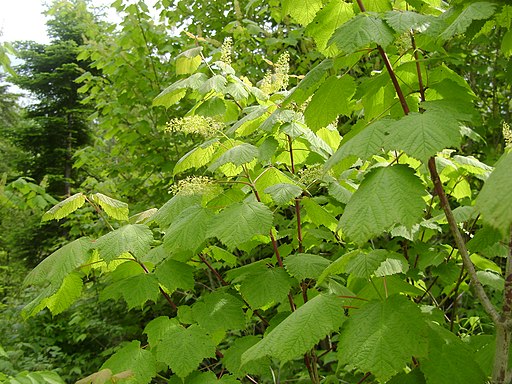Classification System: APG IV
Superregnum: Eukaryota
Regnum: Plantae
Cladus: Angiosperms
Cladus: Eudicots
Cladus: Core eudicots
Cladus: Rosids
Cladus: Eurosids II
Ordo: Sapindales
Familia: Sapindaceae
Subfamilia: Hippocastanoideae
Tribus: Acereae
Genus: Acer
Species: Acer spicatum
Name
Acer spicatum Lam., Encycl. 2: 381 (1786).
References
Additional references
Murray, A.E., 1970. A monograph of the Aceraceae. Unpublished Ph.D. dissertation, The Pennsylvania State University. Reference page.
Gelderen, D.M. van, Jong, P.C.de & Oterdoom, H.J. 1994. Maples of the world. Timber Press, Portland, Or., 458 pp. ISBN 0-88192-000-2. Reference page.
Govaerts, R.H.A. 1995. World Checklist of Seed Plants 1(1, 2). 483, 529 pp. MIM, Deurne. ISBN 90-341-0852-X (issue 1) ISBN 90-341-0853-8 (issue 2). Reference page.
Jones, R.L. 2005. Plant life of Kentucky. An illustrated guide to the vascular flora. 833 pp. Lexington, KY: The University Press of Kentucky. ISBN 0-8131-2331-3. JSTOR Paywall. Reference page.
Chester, E.W., Wofford, B.E., Shaw, J.T., Estes, D. & Webb, D.H. (eds.) 2015. Guide to the Vascular Plants of Tennessee. 813 pp., University of Tennessee Press, Knoxville. ISBN 978-1-62190-100-6. Reference page.
Gilman, A.V. 2015. New flora of Vermont. Memoirs of the New York Botanical Garden 110: 1-614. ISBN 978-0-89327-516-7Reference page.
Werier, D. 2017. Catalogue of the Vascular Plants of New York State. Memoirs of the Torrey Botanical Club 27: 1–542. JSTOR Reference page.
Links
USDA, ARS, Germplasm Resources Information Network. Acer spicatum in the Germplasm Resources Information Network (GRIN), U.S. Department of Agriculture Agricultural Research Service. Accessed: 08-Apr-12.
Govaerts, R. et al. 2020. Acer spicatum in Kew Science Plants of the World online. The Board of Trustees of the Royal Botanic Gardens, Kew. Published online. Accessed: 2020 January 7. Reference page.
International Plant Names Index. 2020. Acer spicatum. Published online. Accessed: 7 January 2020.
Vernacular names
suomi: Tähkävaahtera
français: Érable à épis
íslenska: Fjallahlynur
latviešu: Vārpainā kļava
polski: Klon kłosowy
svenska: Axlönn
Acer spicatum, the mountain maple, dwarf maple, moose maple, or white maple, is a species of maple native to northeastern North America from Saskatchewan to Newfoundland, and south to Pennsylvania. It also grows at high elevations in the southern Appalachian Mountains to northern Georgia.[3]
Description
Acer spicatum is a deciduous shrub or small tree growing to 3–8 m (10–25 ft) tall, forming a spreading crown with a short trunk and slender branches. The leaves are opposite and simple, 6–10 cm (2+1⁄4–4 in) long and wide, with 3 or 5 shallow broad lobes. They are coarsely and irregularly toothed with a light green hairless surface and a finely hairy underside. The leaves turn brilliant yellow to red in autumn, and are on slender stalks usually longer than the blade. The bark is thin, dull gray-brown, and smooth at first but becoming slightly scaly. The fruit is a paired reddish samara, 2–3 cm (3⁄4–1+1⁄4 in) long, maturing in late summer to early autumn.[4]
Flowering tree
Fruits (samaras) with measurement for scale
Distribution and ecology
The tree lives in moist woods in rich, well-drained soils on rocky hillsides and along streams. It also grows on ravines, cliff faces, and forested bogs. It colonizes the understory of hardwood forests.[5]
Mammals such as moose, deer, beavers, and rabbits browse the bark; ruffed grouse eat the buds.[5]
Uses
The sap is a source of sugar and can be boiled to make maple syrup. The bark contains tannins, which are used in tanning leather. Indigenous peoples infused the piths of young twigs to produce treatments for eye irritation and made poultices from boiled root chips. It is also said to be used to relieve stress in humans.[6] The wood has been a popular choice for making musical instruments because of its high strength and durability. [7]
References
1819 illustration. Source The North American sylva, or A description of the forest trees of the United States, Canada and Nova Scotia ... to which is added a description of the most useful of the European forest trees ... Translated from the French of F. Andrew Michaux.
Crowley, D.; Rivers, M.C. (2018). "Acer spicatum". IUCN Red List of Threatened Species. 2018: e.T193872A2287797. doi:10.2305/IUCN.UK.2018-2.RLTS.T193872A2287797.en. Retrieved 11 November 2021.
"Acer spicatum". County-level distribution map from the North American Plant Atlas (NAPA). Biota of North America Program (BONAP). 2014. Retrieved 3 September 2016.
Rook, Earl J.S. (2002). "Moose Maple, Acer spicatum". Shrubs of the Northwoods. Archived from the original on November 27, 2005.
Little, Elbert L. (1980). The Audubon Society Field Guide to North American Trees: Eastern Region. New York: Knopf. p. 581. ISBN 0-394-50760-6.
"Acer spicatum". Plants for a Future.
"Fox Products - Fox Model 920".
Retrieved from "http://en.wikipedia.org/"
All text is available under the terms of the GNU Free Documentation License


